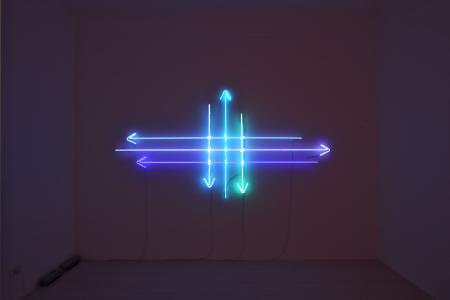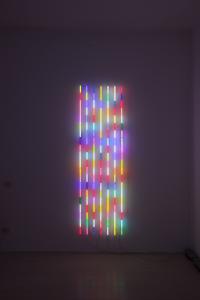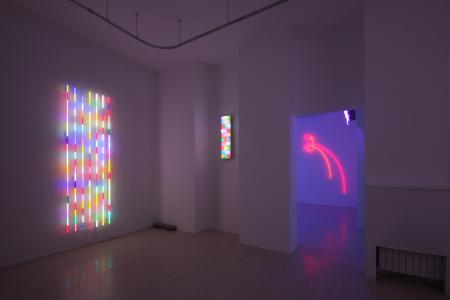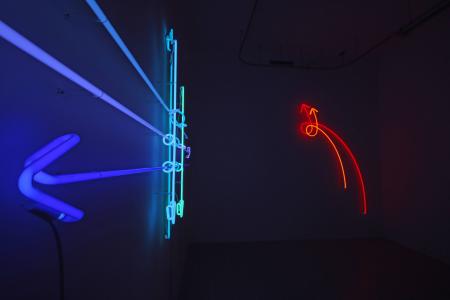Albert Hien
papalapap
21 November 2019
- 20 January 2020
VIA M. GIURIATI, 9 - 20129 MILANO
Menhir Arte Contemporanea è lieta di annunciare la prima mostra in galleria dello scultore tedesco Albert Hien curata da Rossella Farinotti.
La mostra dal titolo papalapap aprirà al pubblico il 21 novembre e rimarrà visibile fino al 20 gennaio 2020. Le opere esposte sono un insieme di lavori al neon realizzati dall'artista in dialogo con gli spazi della galleria dove la parola, nei suoi molteplici significati, assume il ruolo di protagonista. I caratteri colorati sulle pareti catturano la nostra attenzione rivolgendola all'aspetto formale ed estetico del linguaggio. Le parole scritte con il neon sembrano essere lasciate sospese - si stagliano dal muro all'occhio in un luogo immateriale fatto di luci e colori. Albert Hien preferisce il mezzo del neon per il suo carattere evanescente ma, come scultore (ha partecipato a Documenta 7 e 8), il distacco di segni e lettere dalla superficie e la loro ricombinazione come scultura, diventa l'obiettivo prioritario dell'artista. La specifica materialità e la tecnica utilizzata per creare sistemi al neon, così come l'effetto cromatico, rimangono una costante nella sperimentazione artistica di Hien dal 1989 in poi. Le opere esposte in galleria esprimono l'intenzione dell'artista di giocare con il linguaggio, combinando diversi idiomi e parole di uso comune per comporli insieme esattamente come un puzzle. Albert si riferisce alla parte infantile della nostra memoria, in cui la componente ludica invade la sfera razionale, riportando la nostra attenzione all'ascolto delle emozioni primordiali.
Durante l'età evolutiva il gioco svolge diverse funzioni motorie, intellettuali, sociali, emotive e affettive. In particolare, il gioco permette al bambino di allenare la mente e il corpo, sviluppare l'immaginazione, controllare le emozioni. Hien, a volte privando il linguaggio di significato scomponendo e riassemblando i nostri codici di comunicazione, riflette sull'immagine e sulle sensazioni che ne derivano. Papalapap, il titolo di un'opera esposta che dà il nome alla mostra in galleria, diventa il manifesto di un nuovo linguaggio, fine a se stesso, colorato e curioso. La trasformazione performativa dei singoli elementi che formano una frase o una parola è forse l'aspetto principale del carattere della mostra.
Il risultato della ricerca di Albert Hien sull'enigmatico legame tra contenuto e forma si traduce così in installazioni luminose a volte ironiche, a volte di puro impatto estetico. Le lettere diventano veicoli di sensazioni che gradualmente dai colori accesi di alcune sculture diventano monocromatiche, fino all'essenzialità del bianco e del nero.
La mostra sarà accompagnata da un contributo critico di Rossella Farinotti.
Albert Hien è nato a Monaco nel 1956 - vive e lavora tra Monaco e Hochstätt in Germania.
Nel 1982 - da studente - Hien è stato invitato alla sua prima partecipazione a Documenta a Kassel. Quello che seguì fu una rapida carriera con numerose mostre e installazioni su larga scala: al nuovo Hans-Hollein-building del Museum Abteiberg Mönchengladbach sotto l'egida del leggendario Johannes Cladders nel 1984, al Folkwang Museum Essen sempre nel 1984, alla National Gallery Berlin nel 1985, "Transatlantik" alla Kunsthalle Köln nel 1986 e alla Städtische Galerie im Lenbachhaus nel 1991. Come curatore del contributo alla Biennale tedesca, Armin Zweite ha invitato Albert Hien a San Paolo nel 1985. Hien ha anche partecipato alla Documenta 8 nel 1987. Ha esposto in numerosi musei e fondazioni e dal 2001 è titolare di una cattedra all'Accademia di Belle Arti di Monaco, in Germania.
-
Menhir Arte Contemporanea is pleased to announce the first exhibition of the German sculptor Albert Hien in the gallery curated by Rossella Farinotti.
The exhibition entitled papalapap will open to the public on November 21 and will remain visible until January 20, 2020. The artworks on display are a collection of neon works created by the artist in dialogue with the gallery spaces where the word, in its multiple meanings, takes on the leading role. The colorful characters on the walls catch our attention turning it to the formal and aesthetic aspect of the language. The words written with neon seem to be left hanging - they stand out from the wall to the eye in an immaterial place made of lights and colors.
Albert Hien prefers the medium of neon due to its evanescent character but, as a sculptor (participating in Documenta 7 and 8), the detachment of signs and letters from the surface and their recombination as a sculpture becomes the artist's priority objective. The specific materiality and technique used to create neon systems, as well as the color effect, remain a constant in Hien's artistic experimentation from 1989 onwards. The artworks on show in the gallery express the artist's intention to play with language, combining different idioms and commonly used words to compose them together exactly like a puzzle. Albert refers to the childish part of our memory, in which the playful component invades the rational sphere, bringing our attention back to listening to primordial emotions.
During the developmental age, the game carries out various motor, intellectual, social, emotional, and affective functions. In particular, the game allows the child to train the mind and the body, develop imagination, control emotions. Hien, sometimes depriving the language of meaning by breaking down and reassembling our communication codes, reflects on the image and on the sensations that derive from them. Papalapap, the title of an exhibited work that gives its name to the show in the gallery, becomes the manifesto of a new language, an end in itself, colorful and curious. The performative transformation of the individual elements that form a sentence or word is perhaps the main aspect of the character of the exhibition.
The result of Albert Hien's research into the enigmatic link between content and form thus translates into luminous installations that are sometimes ironic, sometimes with a pure aesthetic impact. The letters become vehicles of sensations that gradually from the bright colors of some sculptures become monochrome, to the essentiality of white and black.
The exhibition will be accompanied by a critical contribution by Rossella Farinotti.
Albert Hien was born in Munich in 1956 - he lives and works between Munich and Hochstätt in Germany.
In 1982 – as a student – Hien was invited to his first Documenta participation in Kassel. What followed was a rapid career with numerous exhibitions and large-scale installations: at the new Hans-Hollein-building of the Museum Abteiberg Mönchengladbach under the aegis of legendary Johannes Cladders in 1984, at the Folkwang Museum Essen also in 1984, at the National Gallery Berlin in 1985, “Transatlantik” at the Kunsthalle Köln in 1986 and at the Städtische Galerie im Lenbachhaus in 1991. As curator of the German Biennale-contribution, Armin Zweite invited Albert Hien to Sao Paulo in 1985. Hien also participated in Documenta 8 in 1987. He exhibited in numerous museums and foundations and since 2001 he holds a professorship at the Academy of Fine Arts in Munich, Germany.



